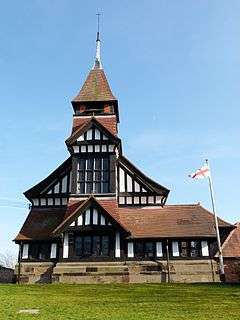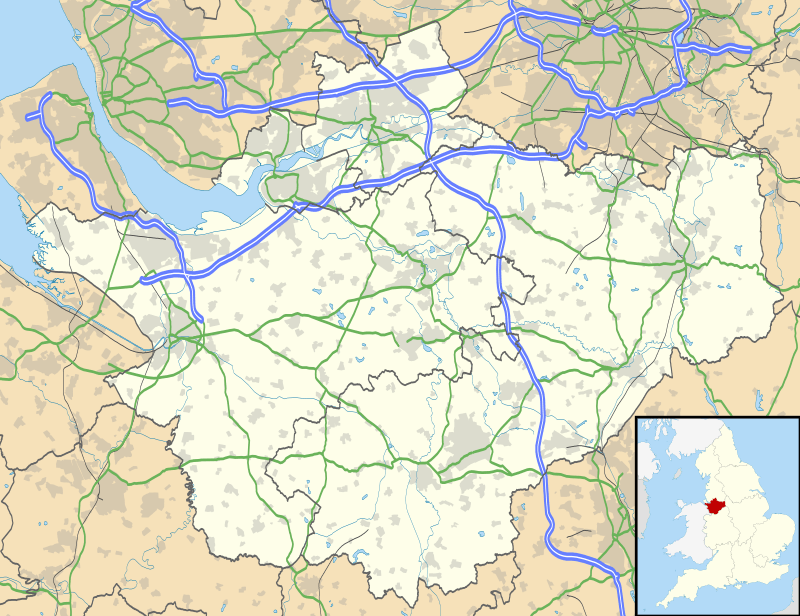High Legh
High Legh is a village, civil and ecclesiastical parish in the unitary authority of Cheshire East and the ceremonial county of Cheshire, England.
| High Legh, Cheshire | |
|---|---|
 Church of St John, High Legh (formerly domestic chapel to the West Hall) | |
 High Legh, Cheshire Location within Cheshire | |
| Population | 1,653 (2011) |
| OS grid reference | SJ700840 |
| Civil parish |
|
| Unitary authority | |
| Ceremonial county | |
| Region | |
| Country | England |
| Sovereign state | United Kingdom |
| Post town | KNUTSFORD |
| Postcode district | WA16 |
| Dialling code | 01925 |
| Police | Cheshire |
| Fire | Cheshire |
| Ambulance | North West |
| UK Parliament | |
Six miles (10 km) north west of Knutsford, seven miles (11 km) east of Warrington and seventeen miles (27 km) south west of Manchester City Centre, according to the 2001 census, the population of the entire civil parish was 1,632,[2] increasing slightly to 1,653 at the 2011 Census.[3]
History
Unusually this village was the seat of two ancient landed gentry families for generations, namely: Leigh of West Hall and Cornwall-Legh of East Hall. Both halls have now been demolished, but both families are still represented today, the head of the "West Hall" family being Sir Edward Leigh MP but no longer associated or living within the parish and that of the "East Hall" family headed by Richard, 6th Baron Grey of Codnor. A member of a cadet branch of the Leigh of West Hall family created a baronet in 1773 for Sir Egerton Leigh, but this title is now dormant and other cadet branches were the Leigh-Traffords of nearby Oughtrington Hall as well as the Barons Leigh of Stoneleigh Abbey in Warwickshire and the Barons Newton of Lyme Park. The third lordship of the manor was held by the Egerton family of Tatton and all three landed families swapped and consolidated their estates throughout the 18th and 19th centuries until the Egerton Leighs sold their High Legh estate to the Cornwall-Leghs just before World War I. When Maurice, 4th and last Lord Egerton of Tatton, sold off the remaining farms and land in High Legh in the 1930s, so ended a connection dating back to the 13th century.
East Hall was demolished in the early 1970s (while West Hall had been some 20 years previously) and the debris was used as foundations for the first Thelwall Viaduct bridge of the M6. High Legh Hall (the East Hall) resembled nearby Tatton Park and the West Hall (Egerton Leigh family) was a beautiful Tudor building similar architecturally to Little Moreton Hall.
In a mainly agricultural area, its proximity to Manchester and the area now known as Gold Trafford has made it nowadays a most desirable residential area.
High Legh was recorded in the Domesday Survey as having two Saxons theins (Ulviet or Wulfgeat, and Dob). The boundary between Mere and High Legh is still known as Dobb Lane and is, in fact, the medieval boundary between the two parishes. A moated site was found some years before, alongside the Roman road which connected Wilderspool and Latchford to Watling Street (A556) and contained Samian pottery from Cirencester, a Roman cloak clasp, and a beautiful flint knife. High Legh was also a high-status Bronze Age burial site. High Legh is the location of an early Methodist chapel in Northwood Lane, with Wesleyan connections. Northwood Methodist Chapel was founded by the Okell family of High Legh (who married into the Egerton Leigh (West Hall) family). In the early 19th century, Robert Moffat, a Scottish lad, came to work on the West Hall estate as a gardener, but in 1814 he joined the London Missionary Society and moved to Plantation Farm in Dukinfield. In 1816 he left with his wife for southern Africa where he became a missionary; his daughter met and fell in love with their student preacher, David Livingstone. The oldest building in the parish is believed to be St Mary's Chapel, formerly the domestic chapel of the Cornwall-Legh family of High Legh Hall (or East Hall), which is sometimes open to the public. However, other older buildings in the parish contain wattle and daub but no evidence of their dates is yet established. The Anglican Church of St John was formerly the domestic chapel of the Leighs of West Hall (Egerton Leigh family).
The park of East Hall, High Legh was laid out by Humphrey Repton for George John Legh in 1791, and John Nash was also engaged to create an idyll village (never completed). Repton removed the old toll road (the original Roman road) and dropped it to its present position (the A50), removing the village and creating a more enclosed entrance to the estate and pleasure gardens.
Both mansions were used by the Government for the training of Royal Engineers during World War II after the families moved out; they never returned to their respective halls and subsequently sold the internal section of the estate to two building companies, Wimpey Homes, and Crossley Homes. In the 1980s more of the estate pleasure gardens was sold off for housing to Ideal Homes. In the 1990s another estate was built on the former Army camp buildings, now known as The Belfry. All the street names in these developments have a connection with the history of High Legh through either one of the ancient landed families (Legh & Leigh), prominent people within the parish or parts of the former park (Pheasant Walk).
Coats of arms
.svg.png) Leigh of West Hall
Leigh of West Hall.svg.png) Legh of East Hall
Legh of East Hall
Transport
On 10 October 2009, High Legh Railway (a 7 1⁄4-inch (180 mm) gauge 400-yard (370 m) railway) was opened by Louise Robbins (Headteacher of High Legh Primary School). On 26 November 2011, the railway was extended further making the route a little short of 900 yards (820 m). The extension was opened by Harold Brooks (in the guise of Father Christmas) and Frank Sidebottom from the 71⁄4 Inch Gauge Society; High Legh Railway is operated by Vee Limited. The railway is the brainchild of Andrew John Higgins[4]
Education
There have been three schools in High Legh. The one within the triangle on the side of the A50 is now High Legh Village Hall, managed by High Legh Community Association.[5] The latest school (with new extensions 1993–94) was built on Wrenshot Lane in 1976; this land was donated by Charles Cornwall-Legh (later Lord Grey of Codnor) to Cheshire County Council.
Sport
The village now has several sporting facilities including High Legh Cricket Club[6] which plays at Arley Hall the home of the Viscount Ashbrook, golf at High Legh Park Country Club[7] on land formerly part of the West Hall estate, High Legh Bowling Club, opposite the Village Hall [8] and High Legh Tennis Club.[9] In 2008 an annual early season 10K running race was started, called the High Legh Robert Moffat Memorial 10K race. It has developed into a very popular local race, with dozens of residents volunteering to marshal, and hot refreshments being served to runners and supporters at High Legh Primary School. The race is jointly organised by High Legh Community Association [10] and Lymm Runners Running Club[11]
See also
References
- http://www.highleghparishcouncil.gov.uk/
- 2001 census population figures Accessed 14 May 2007.
- "Civil Parish population 2011". Neighbourhood Statictics. Office for National Statistics. Retrieved 13 March 2016.
- High Legh Railway. Railway Website. Retrieval Date: 10 December 2009.
- Official Website High Legh Community Association Retrieval Date 7 March 2011.
- High Legh Cricket Club. Archived 3 January 2006 at the Wayback Machine Official Website. Retrieval Date: 17 January 2008.
- High Legh Park Country Club. Official Website. Retrieval Date: 17 January 2008.
- High Legh Bowling club official site
- High Legh Tennis Club. Official Website. Retrieval Date: 13 March 2013.
- High Legh Community Site
- Lymm Runners Official Site